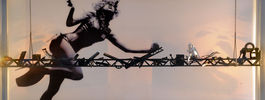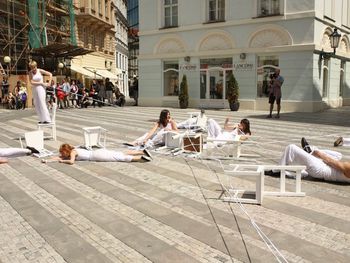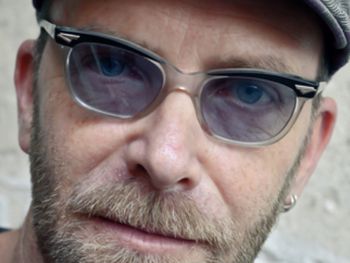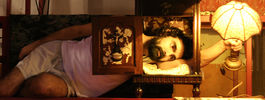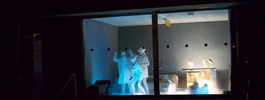
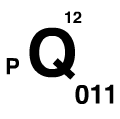
1983 » Vietnam » Scénická a kostýmní tvorba národní expozice
Vietnam
For the first time, the scenic art of the Vietnamese Socialist Republic is being shown at the Prague Quadrennial. Its thousand-year history makes Vietnamese theatrical art an integral part of the great theatrical culture of the Orient. But because of the exceptionally moving national history of Vietnam it has remained almost unknown to the world. At the time when the world was becoming acquainted with the cultures of India, China and Japan, the Vietnamese people were engaged in the struggle for national independence. It was only in the most recent few years that the basic conditions for presenting the very rich Vietnamese theatrical culture to the world at large have been formed. But if we are to speak of contemporary theatrical culture in Vietnam we must be aware of the fact that tradition is its indivisible component and represents the predominant type of contemporary theatre in Vietnam. Vietnamese traditional theatre has survived for centuries under marginal conditions from the point of view of the conditions for its existence. A number of its ensembles were active at the fronts of the national liberation struggle during its whole duration. Traditional theatre has been and continues to be for the Vietnamese one of the basic needs of life. The Vietnamese theatre as a part of an Oriental theatrical culture is characterized by a sharply anti-illusionist approach to scenic designs. This is also apparent in the work of the actors, who are the main axis of a total theatrical synthesis (of music, dance, singing, words and movement), as well as of other scenic components: the creation of space, costumes, stage masks and props. Vietnamese traditional theatre — the court TUONG and the popular CHEO — whose roots go back to the beginning of this millenium, has always been played on a bare stage. The actors, only on the basis of their acting, enriched with a number of symbolic procedures and action and with the help of theatrical props and the sign function of costumes and masks, express the required dramatic time and space. The scenic procedures of the TUONG court theatre have reached exceptional perfection and refinement in this direction. Costumes and masks are the dominating visual elements on the stage, which fulfils the requirements of a high aesthetical effect. The audience, on the basis of the type and color of the costume, as well as according to the type of make-up and mask, recognizes the precise social status and characteristics of the character. Selected and very expensive materials and decorations are used for making of costumes and even seemingly unimportant parts of a costume have their special sign function (for instance bright little flags of triangular shape sewn fan-like to the back of the top part of a costume form an accessory typical for the martial dress of generals). Spatial problems are solved by the actors with the help of conventional indications of sets and props which often have a symbolic function (for instance a table and chairs can signify shields and/or natural objects, a stylized whip with fringes can signify a horse — according to the stylized dance with the whip and with a sword the spectator will precisely identify the method of riding the horse, the type of battle taking place, etc). Similar scenic procedures are also used by the popular CHEO theatre. In contrast to the TUONG which is full of pathos, the CHEO recounts various lyrical tales from the life of ordinary people. The sign and symbolic procedures used are simpler and more comprehensible, make-up is limited to making the basic features of the face (the eyebrows, lips) clearer. Costumes in a whole range of pastel colors are more subdued, even though they also have a standardization function. Besides imaginary props, the CHEO theatre also uses a number of conventional stylized props which have both a real and a symbolic meaning (oars, sticks, an especially important role is played by fans, with which actresses are able to express the fine points of inner mental states). In the southern part of Vietnam CAI LUONG enjoys a similar popularity as Cheo does in the north. In spite of the fact that this type of theatre developed artificially, at the beginning of this century, it is based on very old popular traditions. The influence of the European theatre is clear, but in its original form it also uses traditional anti-illusionist procedures. Extremely colorful costumes also have their standardization functions. A specific aspect of the Vietnamese theatre, which is a rarity throughout the world, is the aquatic puppet theatre. It has a centuries old tradition and is extremely popular above all in the north of Vietnam. Massive wooden figures (of legendary as well as historical characters, dragons, etc), use the surface of a fish pond as their scenic space. They are led by a very artful technique based on a system of various sticks and threads pulled from under the surface, so that the audience participates in a unique atmosphere and an exceptional theatrical experience. In spite of the fact that the range of the present-day Vietnamese theatre is being extended towards European theatrical types of productions (for instance the KICH NO I Drama Theatre has a tradition of a half a century), nevertheless the main representative of contemporary theatrical culture in the Vietnamese Socialist Republic is above all the traditional theatre. We should like to acquaint the visitors to the Prague Quadrennial with it through specific scenic artifacts — above all costumes and props, which besides their theatrical function also are of great historical value.
